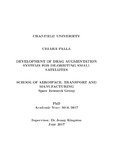JavaScript is disabled for your browser. Some features of this site may not work without it.
| dc.contributor.advisor | Kingston, Jenny | |
| dc.contributor.author | Palla, Chiara | |
| dc.date.accessioned | 2019-07-11T09:29:30Z | |
| dc.date.available | 2019-07-11T09:29:30Z | |
| dc.date.issued | 2017-06 | |
| dc.identifier.uri | http://dspace.lib.cranfield.ac.uk/handle/1826/14327 | |
| dc.description.abstract | The adoption of the ISO 24113 by ESA in 2014 has set an important milestone for the path towards an evolution and worldwide compliance of the Space Debris Mitigation (SDM) requirements. Small spacecraft classes have limited propulsion capabilities or even they are not provided with propulsion subsystem to achieve a controlled re-entry. This issue brings the need to develop affordable de-orbiting technologies with a limited reliance on the system level performance, ideally largely passive methods. The main aim of this research is to develop passive drag augmentation systems (DAS) for de-orbiting small spacecraft at the end of life, enabling them to comply with SDM requirements. After a feasibility study for the potential commercial use of DAS, the satellites’ need for passive de-orbiting technologies is investigated through market forecast and future scenarios of spacecraft compliance to the 25 years re-entry requirement. Spacecraft subsystems failures are analysed statistically to assess how they might impact the end of mission phase and to guide in the de-orbiting strategy selection. The applicability of current Cranfield DAS design is assessed by developing a simple model for preliminary drag area calculation, validating it with STELA and DRAMA, and calculating the additional area needed vs the area provided by DAS for a spacecraft sample. The requirements for DAS are analysed considering the customer’s needs with respect to the internal design drivers. A design parameters analysis is performed to evaluate the scalability of the DAS and their compatibility with satellite platforms. The parametric study together with the requirements analysis provide useful input to explore new concepts based on the heritage designs. In parallel, the De-Orbit Mechanism (DOM) technological demonstrator is developed from prototype model up to flight model, after undergoing qualification test campaign. The DOM will fly on board the upcoming ESA ESEO mission. This research will enable a commercial DAS products offering that will be an attractive solution for small satellite integrators, allowing them to meet debris mitigation requirements. | en_UK |
| dc.language.iso | en | en_UK |
| dc.rights | © Cranfield University, 2015. All rights reserved. No part of this publication may be reproduced without the written permission of the copyright holder. | |
| dc.subject | Space debris mitigation | en_UK |
| dc.subject | clean space | en_UK |
| dc.subject | de-orbiting | en_UK |
| dc.subject | drag augmentation | en_UK |
| dc.title | Development of drag augmentation systems for de-orbiting small satellites | en_UK |
| dc.type | Thesis | en_UK |
